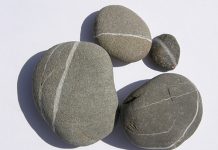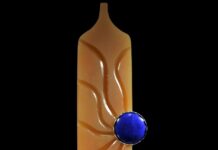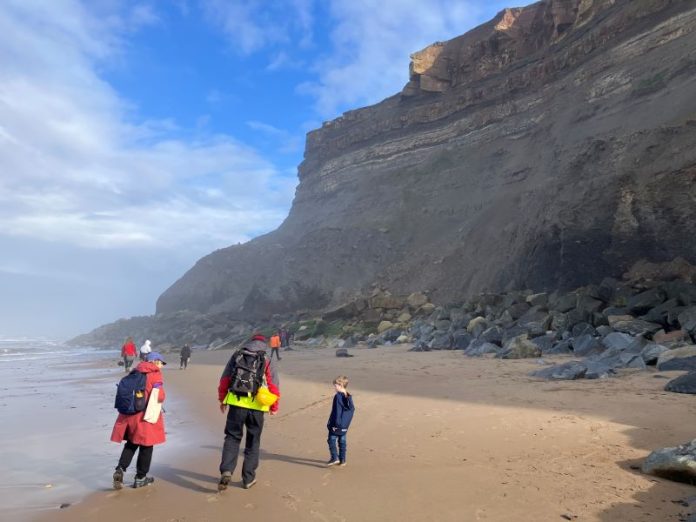
Whitby Dinosaur Coast is England’s lesser-known but equally impressive answer to the famous Jurassic Coast of the southwest. While Mary Anning’s World Heritage Site draws fossil fanatics from around the world with its ammonites and sea monsters, Whitby’s stretch of the northeast Yorkshire coast offers a parallel universe of prehistoric treasures. Centered around the historic seaside port, the so-called “Dinosaur Coast” holds wonders far beyond fossils, making it a destination you won’t soon forget.
Jurassic Fossils Revealed Along the Whitby Dinosaur Coast
Rocks exposed along the Yorkshire coast span almost the entirety of the Jurassic Period, which falls smack in the middle of the Mesozoic Era, or the Age of Dinosaurs. Exposed sediments of the Redcar Formation were laid down 195 million years ago. Subsequent layers piled on top provide an unbroken record spanning the next 60 million years right into the Cretaceous Period. Among the fossils these sediments hold, ammonites are the stars. They are so conspicuous that ammonite motif is found wherever you turn in Whitby: round benches coiled like ammonites alongside cobblestone streets, coiled decorative metalwork, ammonite doorknobs—even the town seal and the official patch of the Whitby Town Football Club.
As the Jurassic Period progressed, this region turned from open seas filled with ammonites to muddy deltaic swampland, thus providing an even greater range of Jurassic fossils than found along Mary Anning’s Jurassic Coast. In addition to ammonites, the cliffs here house remains of marine invertebrates, marine reptiles that chomped on ammonite calamari, dinosaurs and their footprints, leaves and stems of plants and more.
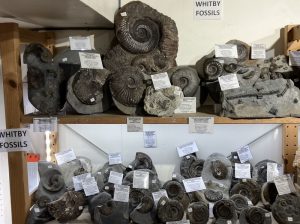
Whitby’s Snakestones: The Ammonite Legend of Saint Hilda
For anyone choosing to believe in miracles rather than science, those abundant ammonites came not from ancient seas but courtesy of Saint Hilda. When she arrived at Whitby Abbey in 657 A.D., before being beatified, Hilda discovered her windswept outpost swarming with serpents. What to do? With staff in hand, in something of a good old-fashioned cattle drive, she rounded them up, herded them to the cliff edge and sent them over. Falling to the beach below, they coiled and turned to stone.
While scientists call these curiosities ammonites, to those in the know, they are St. Hilda’s snakestones. Don’t believe it? Then why is there a whole genus of ammonites called Hildoceras? Supposedly, the heads are missing because Hilda snapped them off with the flick of a whip. To better fit the legend, locals have long gathered ammonites from the beach, carved heads on them, then sold them to gullible tourists.
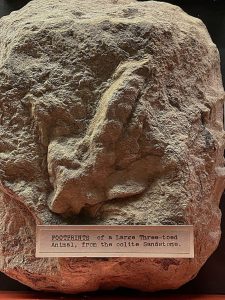
Fossils and Jet at Whitby Museum: A Whitby Dinosaur Coast Gem
To gain a full appreciation of the grand variety to be found along the Whitby Dinosaur Coast, visit Whitby Museum, founded in 1823 by the Whitby Literary and Philosophical Society. You’ll find prehistoric creatures of all sorts tightly crammed together in the marvelously cluttered Victorian fashion of so many British museums. In their advertising, they bill it as “an amazing treasure chest of curious objects, precious gems, ancient fossils, and local legends.”
Although the museum holds all manner of things Whitby-related, a true highlight is the fossil collection. I came prepared for the ammonites and marine reptiles (plesiosaurs, ichthyosaurs, pliosaurs) like those found down south by Mary Anning, but I found much more, including the fossil remains of a complete saltwater crocodilian, dinosaur footprints and carbonized shadows of ancient Jurassic forests.
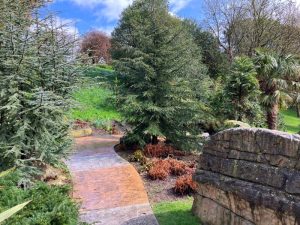
Explore the Jurassic Garden in Whitby’s Pannett Park
You’re familiar with Jurassic Park, the book and the movie? Well, try Jurassic Garden! In Pannett Park, which surrounds and includes Whitby Museum, you are encouraged to “take a step back in time” along “a pathway through the past.” The sidewalk is composed of slabs in different shades of blue, purple, pink and beige, each representing a different rock layer from the Dinosaur Coast and correlated to an interpretative panel at the start of the path to inform your journey through 60 million years of time. Embedded in the path are casts of actual fossils from the region and now housed in Whitby Museum.
The path is shaded by so-called “living fossils”—live tree ferns, araucaria trees, gingkos, and other plants whose ancestral stock would have shaded dinosaurs. My 6-year-old grandson especially liked the life-sized replica of the marine crocodile housed in Whitby Museum embedded in the ground alongside the path as if surfacing in a swamp.

How to Go Fossil Hunting on the Whitby Dinosaur Coast
While museums are great, nothing beats the thrill of getting out and engaging in the hunt for a wee bit of Whitby Dinosaur Coast treasure. Via Google, you’ll find guidebooks and websites providing all manner of directions and tips to collecting accessible beaches beneath Yorkshire cliffs. Each author seems to have a favorite locality. With so many beaches to choose—and each one clearly being the best—what’s a poor tourist to do?
My wife, grandson and I opted to enlist an expert. We went under the tutelage of local fossil guide Liam Herringshaw, who took us to a convenient spot a short walk from town. Unfortunately, the swells were against us due to one of the storms perpetually brewing in the North Sea, and we weren’t able to get around a point where the good stuff was. While we found only bits and pieces, including clams and a good “burger” (a concretion with the edges of an ammonite peeking out all around), we still enjoyed a great experience as Liam provided background about the geology and paleontology of the cliffs towering above us, as well as tales of the history of collecting here and a good bit of social history. Even the rain held off for us. Briefly.
If you’re the type who wants guaranteed success collecting quality specimens, then follow the cobblestone streets back in town to a little shop called Natural Wonders. There, shelves are jam-packed with local fossils. Whether you are seeking the perfect Whitby ammonite or an ichthyosaur bone or two, that’s the place to go. They can also hook you up with a local field trip guide and they provide regularly scheduled fossil-hunting tours of their own throughout the year. They’ll even professionally prepare your finds for you.

Whitby Jet: The Fossil Gem That Sparked a Victorian Industry
Going back 2,000 years and more, one Whitby fossil attracted special attention: jet. In particular, jet from the Jurassic Jet Rock unit of the Mulgrave Shale Member of the Whitby Mudstone Formation. Jet stone is a unique type of dense coal derived from logs of araucaria trees that drifted into Jurassic seas, where they became waterlogged and sank into soft muds below. Tough but easily carved, jet became a favored lapidary material around Yorkshire going back to the Neolithic period. Romans invading Eboracum (York) in 71 A.D. loved it, as did later invaders like the Vikings, who sacked Whitby Abbey in 867 A.D. (The poor abbey seems to have been a prime target for sacking throughout history; German ships even lobbed shells its way during World War I.) When Queen Victoria embraced jet as mourning jewelry upon the death of her beloved Prince Albert, a full-scale industry of jet mining and carving took off in Whitby in the 1800s.
In addition to its fossils, Whitby Museum houses a superb collection of jet and things crafted from jet, from jewelry to rosary beads to chess boards to a scale model of Whitby Abbey. Still more jet and jet artifacts may be found at Heritage Jet Jewellers Museum, billed as “the last remaining jet workshop” from the Victorian heyday. It showcases an entire jetworks in all its dusty glory as found by accident during a building renovation, bricked up in a forgotten attic.
This little museum is in the medieval quarter of town, where you’ll also find a host of shops selling contemporary jewelry crafted by a thriving local jet industry. Some carve in traditional patterns while others take distinctly contemporary twists. Two of my favorites were The Ebor Jetworks and W. Hamond’s, established in 1860 and billed as “The Original Whitby Jet Shop.” Just walking the ancient cobblestone streets and peering into all the shop windows is a thrill in itself. The local industry is helped by New Age, Goth and Wicca aficionados who make pilgrimages to Whitby. Why Whitby? Not only is there the Gothic allure of black jet jewelry, the misty ruins of Whitby Abbey also inspired Bram Stoker to write his Dracula novel, which is celebrated every year here by contemporary would-be witches around Halloween.
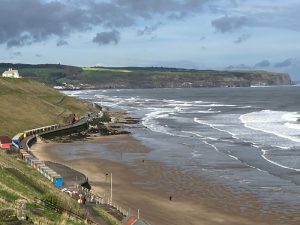
Resources for Planning Your Whitby Adventure
Books
- Dean R. Lomax, Fossils of the Whitby Coast: A Photographic Guide
- Peter F. Rawson & John K. Wright, Geology of the Yorkshire Coast
- James J. Browne, Collecting Fossils between Whitby and Sandsend
- Roger Osborn, The Dinosaur Coast: Yorkshire’s Rocks, Fossils and Landscape
- Roger Osborn, Yorkshire’s Jurassic Fossils
- Hugh P. Kendall, The Story of Whitby Jet
- Helen & Katy Muller, Whitby Jet
Websites
- The Whitby Guide, https://www.thewhitbyguide.co.uk/
- Whitby Museum, https://whitbymuseum.org.uk/
- Natural Wonders Fossil Shop, https://www.fossils-uk.com/map/natural-wonders-ltd
- W. Hamond, https://whamond.com/en-us
- The Ebor Jetworks, https://eborjetworks.co.uk
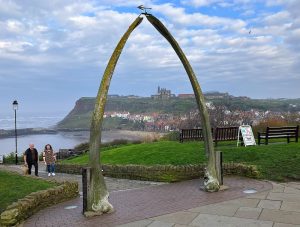
Whitby’s Many Claims to Fame
Forget the fossils! There’s a lot more to explore at Whitby. Here’s a handful of highlights:
- Roman & Viking Invaders
- Saint Hilda & Whitby Abbey
- The 199 Steps
- Whalebone Arch
- Captain Cook
- Count Dracula
- Shops catering to Goth fashion
- Whitby Swing Bridge over the River Esk
- Whitby Amusements (great for kids!)
- England’s best fish-n-chips (or so they say…)

Whitby History and Legends Beyond the Whitby Dinosaur Coast
That Dracula connection and the lovely tale of Saint Hilda and her snakestones are just two of the many reasons beyond fossils for planning a trip to Whitby. I’ve mentioned the Roman and Viking occupations for history buffs. For anyone into maritime history, Whitby is where none other than Captain James Cook earned his sailing chops and had his ship, the Endeavor, constructed, and you can visit the house where he once lived. It’s now a museum dedicated to his nautical adventures. You’ll also see evidence throughout town of Whitby’s past as a whaling village. Folks have lived here for at least 3,000 years, so it’s seen a lot of traffic and has accumulated an outsized history for its relatively small footprint. Oh, and did I mention fish-and-chips? Whitby is rumored to have the very best, although I understand those are fighting words on the English coast. To decide for yourself, stop by the Magpie Café and many other fine eateries for a sample.
A great part of the Whitby experience is just how compact this fishing village is. A snug old medieval section with cobblestone lanes hugs the harbor. Above, a Victorian section offers broad boulevards and fine views of the ruins of Whitby Abbey and the dramatic cliffs of the Dinosaur Coast. It’s easy to walk from one part to the other and all around town, and then down to the beaches abutting fossil-filled cliffs. Plus, informational panels are posted everywhere, so you don’t even need a guide to gain in-depth knowledge of local history.
Whitby Dinosaur Coast: Final Thoughts
Want to plan a Whitby Dinosaur Coast excursion of your own? Whether heading south from Scotland or north from London, it’s easily accessed by trains that take you through bucolic territory. Before boarding, check out The Whitby Guide website. You’ll find in-depth info on all things Whitby and its wonderful history, and incredible prehistory. Take time to spend a few days and you’ll still only scratch the surface. A short visit to the Whitby Dinosaur Coast leaves you thirsting for more!
This story about the Whitby Dinosaur Coast appeared in Rock & Gem magazine. Click here to subscribe. Story and photos by Jim-Brace Thompson.









